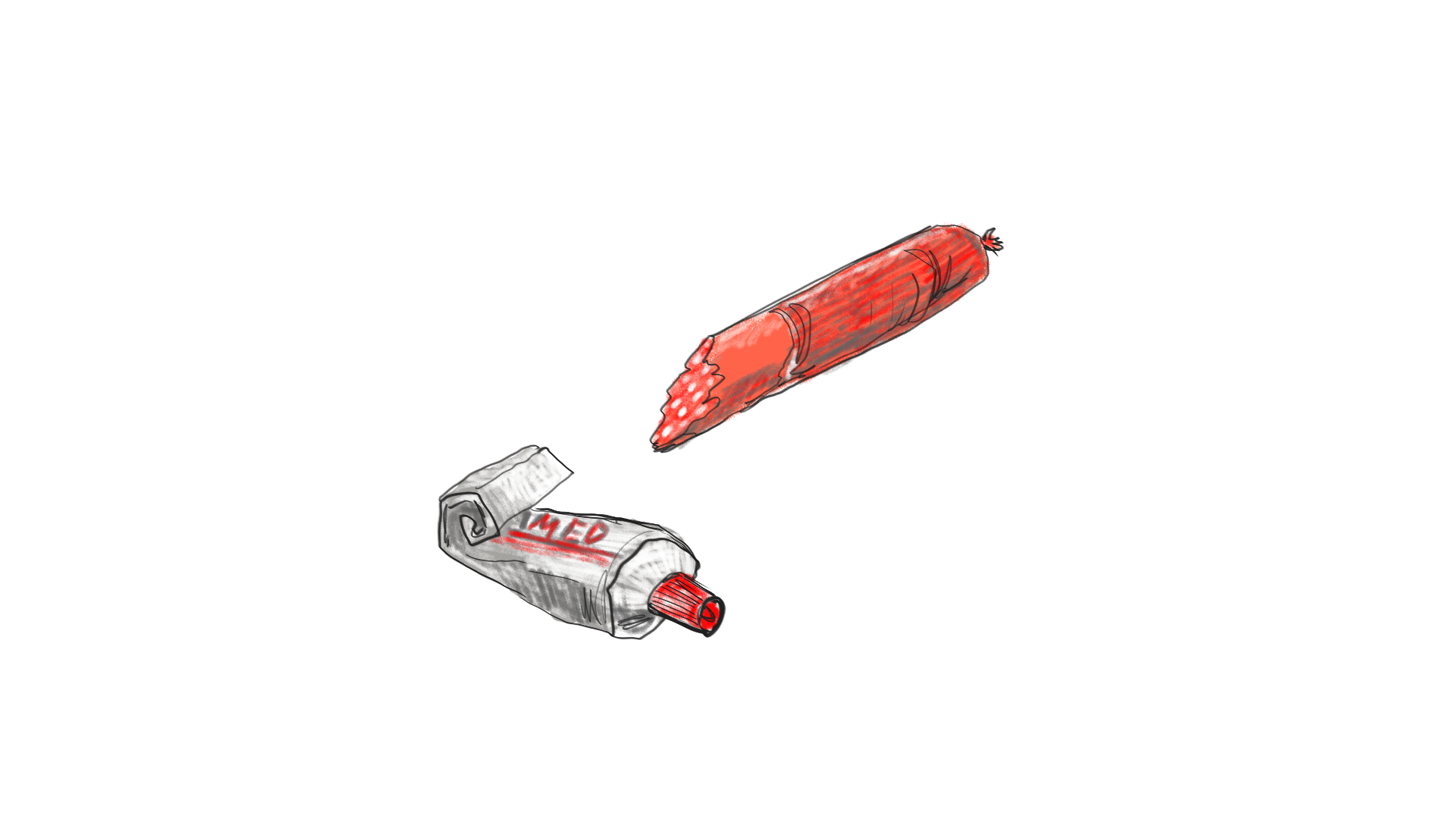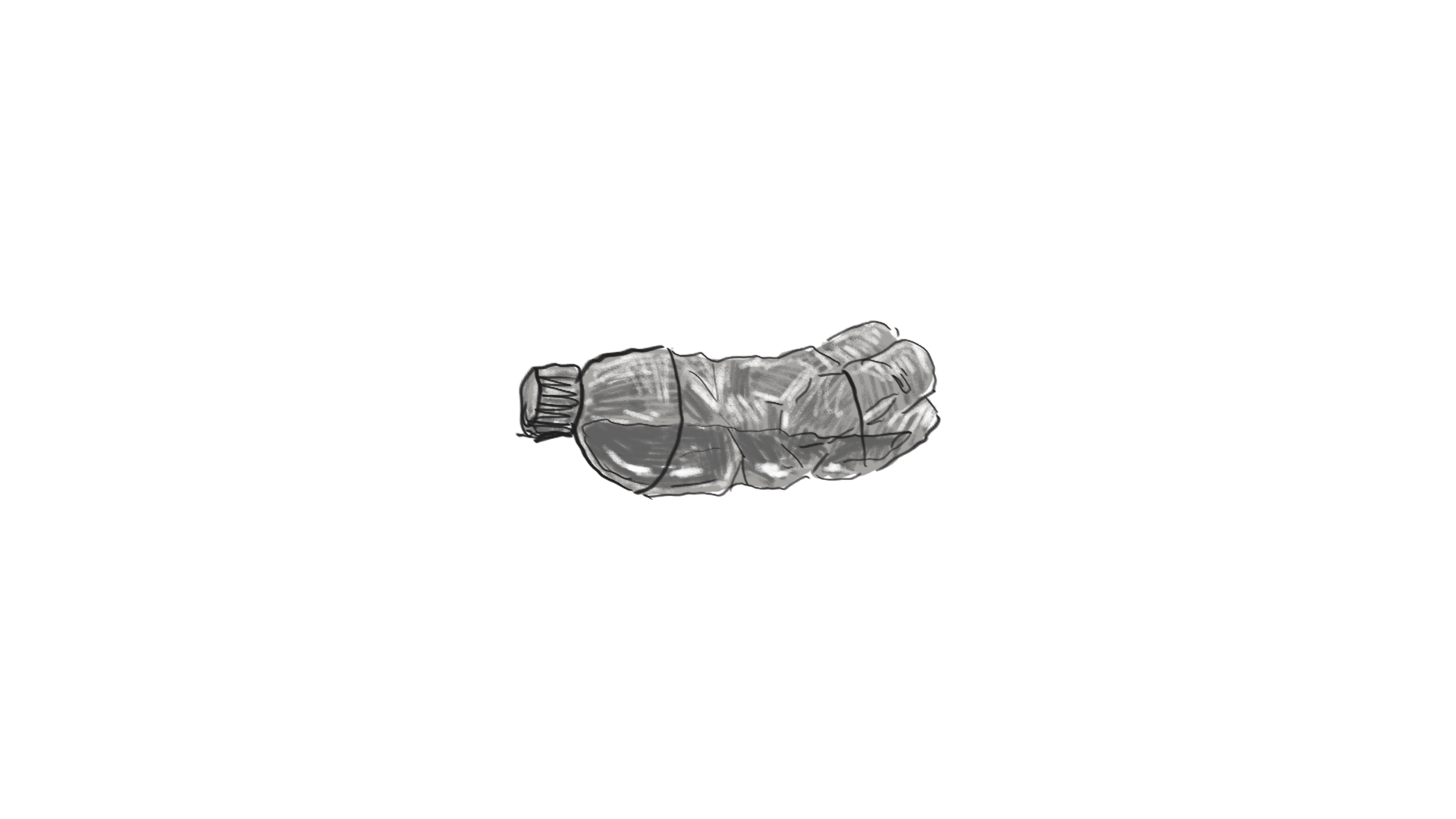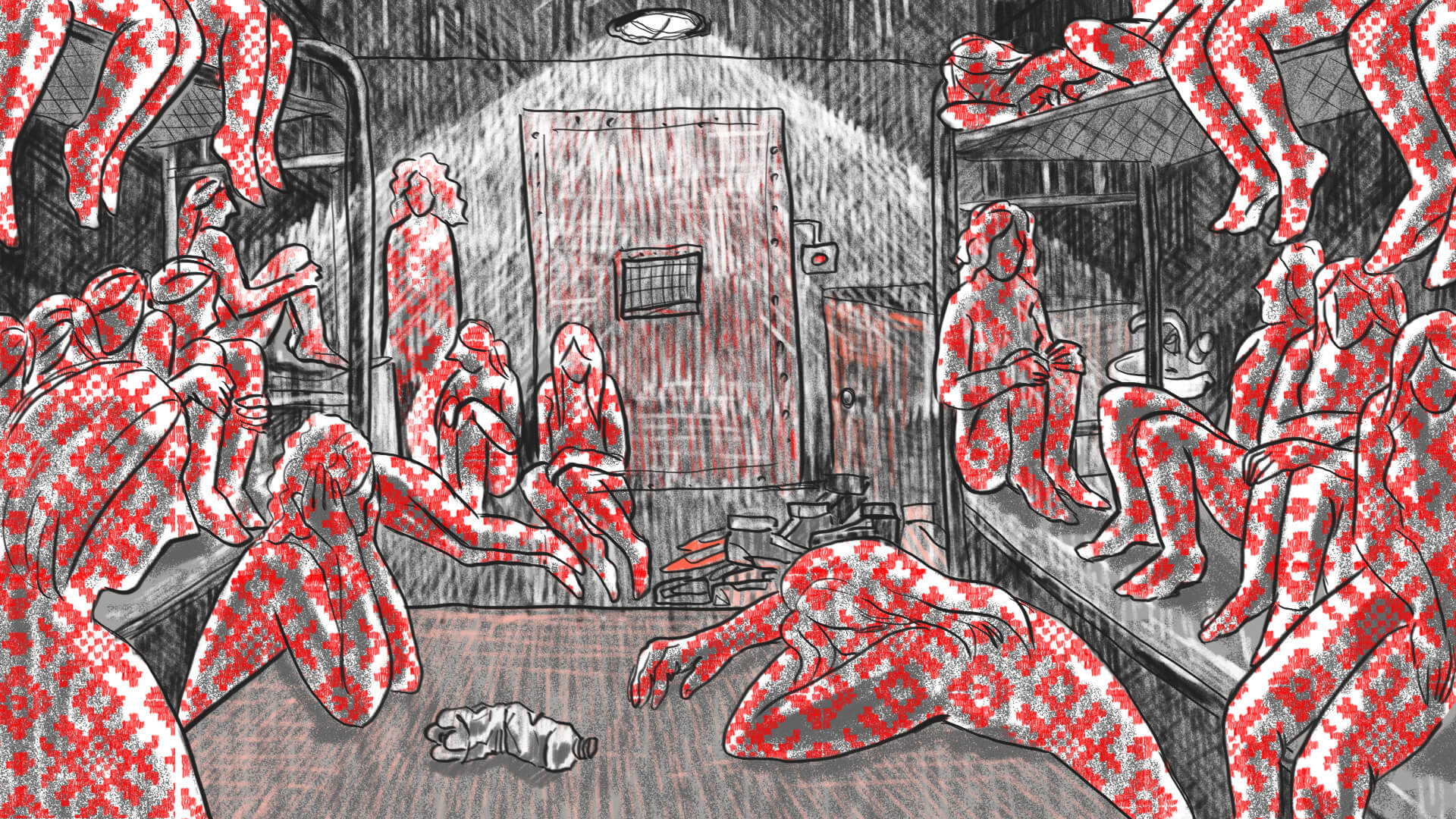The long concrete prison hallway is punctured with iron-clad doors that lead into cells. The door has a square window, its sash folds down and turns into a shelf. This is the so-called feeder. Interrogations are done through this feeder. Sometimes, when the women inside desperately cry out for air, the guards open the feeder for a bit to let some fresh air in. No feeding happens through the feeder. Only on the end of the third day it will yield six loaves of bread for 36 people.
The cell is about 118 square feet. A sink right near the entrance. Cold, rusty water flows from the tap. It is the only source of water in the cell. It is poured into a crumpled and dirty plastic bottle left behind by previous inmates. The women drink in turns.
Olesya S., Katya K. and several other women manage to wash their hair with the anti-lice shampoo over the sink. Half a bottle of shampoo was also left behind by some of the previous inmates.
There are two black soap bar slivers on the sink. Many women try to use them to wash their clothes. They decide to pile everyone’s shoes under the sink. If people leave their shoes randomly on the floor, they will run out of space to walk or stand. There, under the sink, on the sneaker pile sleeps Lena A. There is no other space.
There is a toilet next to the sink. A simple hole in the floor. An oblong basin made of rough earthenware with grooved edges is mounted in the hole on the floor level so that one can put their feet on them and spread over the hole like an eagle. No toilet paper. When the inmates ask for some, the guards tell them to wipe with their own clothes.

The toilet is surrounded by a plastic fence, but it is low, only reaching the chest of a standing person. You get complete privacy only by squatting. There are 36 women in the cell, many have upset stomachs due to hunger and stress, so the toilet is almost always occupied. A nearly constant sound and stench of feces comes through the low fence.
There is a button near the toilet. It is a panic button used in cases of emergency if there is a fight or someone becomes sick. If, squeezing to get by on the way to the toilet someone accidentally hits the button, the guards rush in on false alarm, screaming, insulting, and threatening the women.
Two bedside tables on the right. The inmates find a trash bag in one of them with empty cans from canned fish, rather stinky. But in the other table a real treasure is discovered – a nail file hidden in one of the cracks.
Hanna L. gets on top of one of these tables. Nastya B.– inside of it, just below Hanna. After their release Hanna and Nastya will still be amazed that they even managed to get some sleep there, curled up like cats. Though the sleep felt more like a fainting spell that happens from the lack of air.
Two-tiered metal bunks along the wall. Classic prison bunks, rusty and tattered and bolted to the floor. The mattresses are blue and white - flat and lumpy like pancakes. You can hardly call it blue or white, the colors are long gone. The mattresses are covered with blankets, but the women take them off and give them to those sleeping on the floor. There are also four grey pillows. Pillows, blankets and quilts all smell, and when you look at them, you think of lice and scabies.
A table and two benches are squeezed in between the beds and are also bolted to the floor. A barred window above the table. Working in turns with the nail file found in the bedside table the inmates manage to weaken some screws on the bars and open it a little. Some fresh air comes from the streets along with the endless sound of constantly arriving police vans.
The vans come in unbelievable numbers - my God, how many people have they managed to snach? The cell gets alarmingly little air. There is a ventilation vent, but for some reason it is tightly stuffed with toilet paper and the inmates fail to clear it out.
Light and dampness
The light in the cell is always on - an old Gulag habit. So Nastya B. sleeps with her head in the bedside table, it gives her at least some protection from the light. This is why spaces under the bunks and the table are considered to be the best. They lose their premium quality, however, once the floor becomes damp.
Dampness is created by the guards. Perhaps as a retaliation for the noise, possibly as a disinfection measure. Sure, the cell is noisy. There are no screams or loud conversations, but five, six, ten women are always negotiating how to step over each other, how to make themselves comfortable, how to roll over.
Lena A. has a red handbag. Her parents managed to give her a care package in the court building. The bag contains a stick of smoked sausage and a tube of toothpaste. Lena shares them with her neighbors. The women bite the sausage, sometimes just take a whiff of it, smear some toothpaste over the gums – a feeling of lost cleanliness. Sharing also creates a hum of voices.
Sometimes someone’s nerves give up:
- Come on, put away you shoes already!
- I told you they are not mine. Girls, whose sneakers are these?
They are trying to be cordial to one to another, but such emotional outbursts can’t be avoided. Every minute someone screams of something.
If the feeder is open for some ventilation, the women in the cell can hear how men are being beaten in prison corridors. Sounds of sharp whipping blows and primal screams of the beaten. After their release Nastya B., Olesya S., Hanna L. will all be saying in unison: we could not ever imagine that a human being can scream so.

When they hear the screams, women in cell #18 imagine that it is their husbands and sons who are being beaten. Zhanna L. witnessed her husband’s arrest. And Katya K. saw her husband in the police van with his hands behind his back, secured with a plastic tie. And Olesya S. saw her boyfriend being arrested. Isn’t he the one being beaten in the corridor right now? Aren’t these desperate, almost animal sounds his?
And many women cry. Some quietly, some howl. Some, like Yulia G., experience hysteria or panic attacks. These people are consoled and comforted. One constant, unending hum of voices.
On top of it all, the guards took Hannah L.’s glasses, and she tries to get them back but in vain. Katya K. has the opposite problem – she wears contacts, and her eyes are burning. She is complaining to Hanna. Zhanna L. is a diabetic. Her medicine was confiscated during the frisk search and Zhanna wants it back. Also in vain. Constant, unending hum of voices.
And some people go mad. Like that woman, whose last name no one can remember at this point. She suddenly stands up, straightens her clothes, and says:
- All right girls, it’s fun to be here with you but I have to go. Goodbye. It was nice meeting you.
She goes to the door, jerks it a couple of times and turns around:
- Girls, it 's locked. Who has the key?
And after a pause:
- Girls, this isn’t funny anymore. Give me the key.
She knocks on the door. Waits a little. Knocks louder.
At this very time someone tries to squeeze into the toilet and accidentally hits the panic button.
Cries, hums, laments, knocks on the door, alarms – these are the moments when the feeder opens, and the guard starts yelling:
- Shut up you all or I’ll bury you!
And sometimes not the feeder, but the entire door swings open and one of the guards throws a bucket of water into the cell water splashing everywhere. Many prisoners think that it is their way of punishing them for the noise. Many people detect a strong smell of bleach and think that this is their way of disinfecting. Either way people sitting on the floor are now all drenched. And the blankets they use to cover the floor during sleep are also wet. And the spaces under the beds previously so alluring because of the darkness, are no longer considered such because of the water.
Water, however, quickly evaporates. It hangs in the air in tiny droplets of fog, condenses on the walls, slowly runs down along them. And the air is nearly completely devoid of oxygen. It is almost pure carbon dioxide.
There is absolutely no air to breathe.
The right to breathe
There comes a point when stuffiness in the cell becomes lethal. Olga Pavlova says you can literally feel this with your body. You lose consciousness, faint, and the last thing you see is that others do the same. Then consciousness returns and Olga Pavlova shouts:
- Open the door! Get us out of here! Otherwise, you will be carrying out corpses!
And other women scream too. The cell screams with one last desperate scream.
The door opens. A guard, who they know is not yet a complete animal, stands at the entrance:
- Hush, girls, hush. I’ll take you out to the corridor. But quietly and face the wall, don’t let anyone hear.
Olga Pavlova guesses that it is probably nighttime. The guard is hoping to let them out for some air without his superiors and colleagues knowing.
The women get up heavily and go out into the corridor. It has an open window and lots of air. They stand facing the wall and breathe.
Nastya B. takes a couple of breaths and faints. Not from the lack of, but from the abundance of oxygen this time.
- She's sick, call the doctor!
- Quiet! The guard hisses.
But it's too late. The guards already heard them, are already running, already shoving them back into their cells. Already called the nurse who is giving some kind of injection to the woman who lost consciousness.
- What are you giving her? Why?
- Adrenaline! Mind your business!
When the woman regains her consciousness and stands up uneasily, and everyone goes back to their cell, the guard says somewhat conspiratorially:
- That’s it, now I’m gonna get it because of you.
He is afraid of an official reprimand for having temporarily stopped torture.


